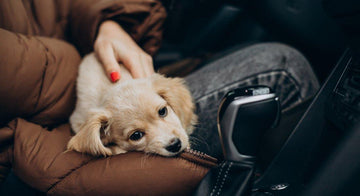
As the weather warms up, travel plans are probably underway, and as a dog parent, your furry friend is likely included in those plans. While some dogs look forward to getting in the car, others may find it overwhelming, leaving them feeling anxious.
Travel anxiety in dogs can spoil an otherwise exciting trip before it even begins. Fortunately, there are some ways to ease your dog's anxiety and make traveling easier for both of you. These include managing the underlying cause of the anxiety and making the trip more comfortable with solutions like dog potty grass with a tray.
What is Dog Travel Anxiety?
Travel anxiety in dogs is the stress or fear that some dogs experience during car rides or other forms of travel. It can result from unfamiliarity with the situation, negative associations with travel, such as going to the vet, or simply the discomfort of being in a moving vehicle.
Separation Anxiety: In other situations, a dog may also associate a car with a negative experience. For example, if the dog was abandoned, they may feel that a car ride meant going to the shelter and being left behind.
Negative Associations: When a dog associates car rides exclusively with trips to places they find unpleasant, such as the vet's clinic or the groomer, they may also develop a negative perception of car travel.
Car Sickness: Sometimes, other dogs experience anxiety in the car for no specific reason. They simply find it to be an unfamiliar or uncomfortable space. Factors like unstable footing when the car is moving and loud noises can be overwhelming. Additionally, like humans, dogs can experience motion sickness, further adding to their discomfort in the car.

6 Tips to Help Your Dog with Travel Anxiety
Symptoms of dog travel anxiety can manifest as whining, constant barking, pacing, drooling, trembling, and even vomiting. Some dogs may also show reluctance to get into the car or display signs of aggressive or destructive behavior. If your dog experiences motion sickness, such as vomiting, it may be helpful to consult your vet for anti-nausea medication.
Get Motion Sickness Under Control
You may confuse travel anxiety with motion sickness, as both can cause symptoms like drooling, restlessness, or other signs of distress. Many dogs experience a mix of both, as nausea can exacerbate travel-related stress. So, it's crucial to address motion sickness along with your dog's anxiety in cars. Consult your vet to discuss these symptoms and to prescribe medications if necessary.
You can also consider some precautionary measures — keep the vehicle cool, crack the window to allow in some fresh air, limit your dog's food intake for a few hours before travel, and create a comfortable spot for them in the car.
Desensitize and Counter-Condition
If your dog shows reluctance to get into the car, you can work on counterconditioning and desensitization techniques.
Help dogs become more accustomed to pet travel by taking them on short trips. You can open the window slightly to allow fresh air and reduce the feeling of confinement. Another helpful tip is to use a dog's ear cover to alleviate noise sensitivity or cover their crate with a blanket to create visual barriers and reduce anxiety, but make sure there is adequate airflow. Alternatively, let them look out the window to see how they respond to the passing scenery.
Remember, your dog's well-being is your top priority. Adjust your approach based on their reaction and reward them with dog treats for calm behavior to create positive associations with travel.
Ensure a Safe Space for Your Dog
Create a safe and quiet space for your dog in the car where they can rest and make traveling with a pet less stressful. Bring along their favorite toy or blanket to provide a sense of familiarity and comfort.
Dogs prefer classical music and often find it calming — try playing some to drown out scary noises and see if it can help relieve stress. Additionally, you can give them a puzzle feeder to keep them entertained and distracted during the journey. Most importantly, make sure to pack enough food and water for the trip to ensure your dog stays hydrated and nourished.

Consider Alternative Solutions
Some dogs feel more secure when they are in a crate. So, instead of letting them loose or using a clip-in harness in the backseat, consider securing your dog in a travel carry-on or pet carrier to see if they feel more comfortable. This can be particularly helpful for air travel, where a carrier is often required.
Ensure the crate is the right size for your dog, allowing them to settle comfortably inside. Practice lifting and moving the carrier while your dog is inside to acclimate them to the sensation. Reward positive behavior with small treats to reinforce a positive association with the carrier.
Try Medication and Non-Medical Calming Aids
Medications prescribed by a veterinarian can also be effective in managing anxiety in dogs. However, it's crucial to conduct a trial run with the medication before your travel to see how your dog will respond to the effects.
Alternatively, non-medical aids like calming vests or homeopathic remedies may also help dogs with mild to moderate anxiety. Calming vests provide gentle pressure that can help dogs feel more secure, and thus reduce anxiety. Homeopathic remedies, such as herbal supplements or pheromone sprays, can also have a calming effect on some dogs. Always consult your vet to determine the most appropriate treatment management for your anxious dog.
Make Bathroom Breaks a Priority
Part of ensuring your dog's comfort during travel involves making sure they're getting enough bathroom breaks. When frequent stops are not possible or you're concerned about not finding a suitable spot for your dog to relieve themselves, portable bathroom solutions like Gotta Go Grass® pads can be incredibly convenient. They allow your dog to potty in a familiar way, reducing the risk of accidents inside the vehicle.
These grass pee pads for dogs are particularly useful for frequent travelers in RVs or boats, as they offer a natural and convenient bathroom option for dogs. Because they are made of living grass, they naturally absorb odors, reducing the need for extensive cleaning often associated with fake grass alternatives. Depending on usage, they can last up to four weeks, and because they are fully biodegradable, they are a more sustainable option than single-use pee pads.
For severe cases of anxiety in dogs, it's advisable to seek help from an experienced dog trainer or veterinary behaviorist. These professionals can develop a strategy to help your anxious dog with car travel. The plan may include desensitization techniques, medications, or other helpful supplements proven to relieve anxiety in dogs.

Takeaway
Traveling with a dog doesn't always involve long journeys or vacations. There are situations when it's necessary to take your dog in the car, such as for vet visits, boarding, or trips to the dog park. It's crucial to help them adjust to this lifestyle, ensuring they feel comfortable and relaxed during car rides.
Make travel more convenient with grass pads for dogs. Shop for Gotta Go Grass® pads on our website today!



